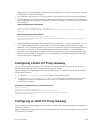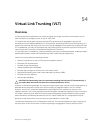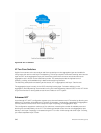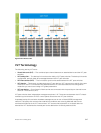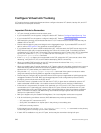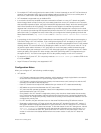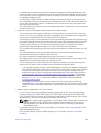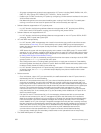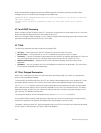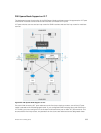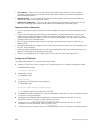
– In the backup link between peer switches, heartbeat messages are exchanged between the two
chassis for health checks. The default time interval between heartbeat messages over the backup
link is 1 second. You can configure this interval. The range is from 1 to 5 seconds. DSCP marking
on heartbeat messages is CS6.
– In order that the chassis backup link does not share the same physical path as the interconnect
trunk, Dell Networking recommends using the management ports on the chassis and traverse an
out-of-band management network. The backup link can use user ports, but not the same ports
the interconnect trunk uses.
– The chassis backup link does not carry control plane information or data traffic. Its use is restricted
to health checks only.
• Virtual link trunks (VLTs) between access devices and VLT peer switches
– To connect servers and access switches with VLT peer switches, you use a VLT port channel, as
shown in Overview. Up to 96 port-channels are supported; up to 16 member links are supported
in each port channel between the VLT domain and an access device.
– The discovery protocol running between VLT peers automatically generates the ID number of the
port channel that connects an access device and a VLT switch. The discovery protocol uses LACP
properties to identify connectivity to a common client device and automatically generates a VLT
number for port channels on VLT peers that connects to the device. The discovery protocol
requires that an attached device always runs LACP over the port-channel interface.
– VLT provides a loop-free topology for port channels with endpoints on different chassis in the VLT
domain.
– VLT uses shortest path routing so that traffic destined to hosts via directly attached links on a
chassis does not traverse the chassis-interconnect link.
– VLT allows multiple active parallel paths from access switches to VLT chassis.
– VLT supports port-channel links with LACP between access switches and VLT peer switches. Dell
Networking recommends using static port channels on VLTi.
– If VLTi connectivity with a peer is lost but the VLT backup connectivity indicates that the peer is
still alive, the VLT ports on the Secondary peer are orphaned and are shut down.
* In one possible topology, a switch uses the BMP feature to receive its IP address, configuration
files, and boot image from a DHCP server that connects to the switch through the VLT domain.
In the port-channel used by the switch to connect to the VLT domain, configure the port
interfaces on each VLT peer as hybrid ports before adding them to the port channel (refer to
Connecting a VLT Domain to an Attached Access Device (Switch or Server)). To configure a
port in Hybrid mode so that it can carry untagged, single-tagged, and double-tagged traffic,
use the portmode hybrid command in Interface Configuration mode as described in
Configuring Native VLANs.
* For example, if the DHCP server is on the ToR and VLTi (ICL) is down (due to either an
unavailable peer or a link failure), whether you configured the VLT LAG as static or LACP, when
a single VLT peer is rebooted in BMP mode, it cannot reach the DHCP server, resulting in BMP
failure.
• Software features supported on VLT port-channels
– In a VLT domain, the following software features are supported on VLT port-channels: 802.1p,
ingress and egress ACLs, BGP, DHCP relay, IS-IS, OSPF, active-active PIM-SM, PIM-SSM, VRRP,
Layer 3 VLANs, LLDP, flow control, port monitoring, jumbo frames, IGMP snooping, sFlow, ingress
and egress ACLs, and Layer 2 control protocols RSTP and PVST only.
NOTE: PVST+ passthrough is supported in a VLT domain. PVST+ BPDUs does not result in an
interface shutdown. PVST+ BPDUs for a nondefault VLAN is flooded out as any other L2
multicast packet. On a default VLAN, RTSP is part of the PVST+ topology in that specific
VLAN (default VLAN).
– For detailed information about how to use VRRP in a VLT domain, refer to the following VLT and
VRRP interoperability section.
– For information about configuring IGMP Snooping in a VLT domain, refer to VLT and IGMP
Snooping.
Virtual Link Trunking (VLT)
951



